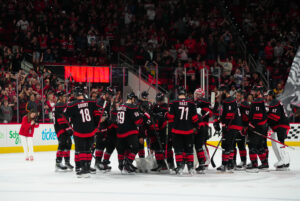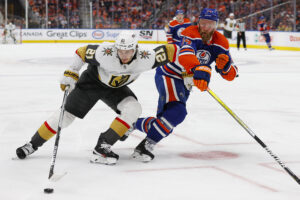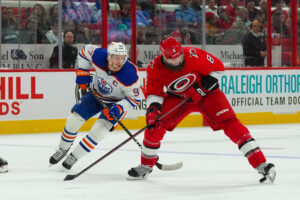Picture this: It’s 1969 and you walk into the old Oakland–Alameda County Coliseum Arena to watch the Oakland Seals. They are playing the Chicago Blackhawks that night. While you’re watching the game there are two players that fight not once, not twice, but three times in the span of the whole game. Seals forward Carol Vadnais and Blackhawks captain Keith Magnuson had been at each other’s throats all night. The feud finally ended when Magnuson knocked out Vadnais in front of the Chicago net. There were no helmets, minimal rules preventing fighting, and the crowd was electric as ever. Flash forward 20 years later and there are players on nearly every roster whose job it was to go out and fight the other team’s equivalent player. These players were the enforcers of the NHL. Similar to the first example, the crowd loved a good hockey fight.
Now let’s take a look at today’s game. Fights happen and the crowd still loves watching two guys beat the lights out of each other. That will never change. But the dynamic that fights occur and the players that do the fighting are not like their counterparts from 30-plus years prior. There are no longer enforcers like Marty McSorley or Tie Domi who go out and fight and rough up the opposition for a living. In today’s game the enforcers, if you can even call them that, look and play a much different role than they did during the 80s and 90s.
The Role of the Modern NHL Enforcers
Tale of NHL Enforcers Past
The league is not far removed from a time when teams had players on their roster for the purpose of fighting and roughing up other players. Not until the middle of the 2000s would the league start seeing a slow shift from that old style of playing and roster management. As the old enforcers began to retire, more skilled play started to become the norm. Players like Patrick Kane and Sidney Crosby were breaking into the league through the draft. Defencemen started playing an active role in creating offence for their teams and not so much laying hits whenever and wherever. Come the 2010s and this trend became more apparent. Skilled, more agile players were being drafted in the early parts of entry drafts. Flashier forwards like Nathan MacKinnon and Tyler Seguin were becoming stars of the league, dominating in a way that the league hadn’t seen in years.
It was around that time that the role of the power forward became a little more integral to teams. Bigger wingers and centres weren’t necessarily only played to fight, but this didn’t mean that they didn’t play a rougher game. Guys like Dustin Byfuglien, David Backes, and Milan Lucic were skilled players. In addition to their raw talent, however, they were some of the roughest and toughest players during their peak seasons. However much skill they had, most of these player types were slowly phased out for even more dynamic power forwards.
The Modern Enforcer
Today’s tough guys don’t drop the gloves at the drop of a hat, and the numbers back it up. In the 2018-19 season, there were .19 fights per game. Despite these trends, there are still players that fill that “enforcer” role.
Tom Wilson
Washington Capitals forward Tom Wilson is the number one example of the modern-day “enforcer”. He’s a power forward for the team. He’s able to drive the play on his own but will mainly be the rougher guy in the lineup. For Wilson, however, he is the best of this category of player. He has the capability to put up 20 goals in a season at his best. Add in his ability to mesh well with any top-six group and this guy is a physical, yet still elite, winger that can lay the law down if the opponent steps out of line. He has a track record for taking too many bad penalties and getting suspended a little too much. But what enforcer, classic or modern-day, doesn’t?
Andrew Shaw
Chicago’s favourite bruiser has established himself in a similar that Wilson takes on. He might not have the consistent scoring touch that Wilson does, but at his best, Andrew Shaw is a quality top-six presence. In his last season for the Montreal Canadiens he put up 47 points, a career season for the then 27-year-old. He was on pace for a 61-point season! For a player that is known to aggravate the other team and throw a few punches often, that’s a rare occurrence. He might not reach that pace again due to health issues, but who knows. Having a 30 point player with the physicality that Shaw brings into your line up is valuable for most teams in today’s league. If Shaw is able to stay healthy, he could be Chicago’s Tom Wilson mini-me.
Evander Kane
Evander Kane is good at hockey. There is a reason why the San Jose Sharks pay him as much as they do. He might not have the size and line mates that Wilson does, but by himself, Kane has proven to play a great power forward role for the Sharks. He’s been a 30-goal-pace player the last two seasons. He has also been known to ruffle some feathers as well, but this isn’t a bad thing in the slightest. He’s the player in San Jose who can score a game-winner one night, and the very next go and protect his top players who don’t have that physical edge to retaliate themselves. Is he an enforcer in the traditional sense? No, but with this modern style of enforcing he lines up perfectly with it.
The Future
There will come a time where even these types of players will also be slowly phased out of the game. The game is only going to get faster, more skilled, and harder to compete with the top players each season. Take a look at the depth forwards in today’s junior leagues across the world. They aren’t poor players who have only one job and that’s to go out and throw the body for the sake of throwing the body. They are just as talented and fast as their top line teammates are. With this trend, fighting and the need for any type of enforcer in the NHL will be all but obsolete. With that being said, ‘The Code’ as players refer to it, will always be a part of the game. If someone steps out of line there will always be players stepping up to prove their point, always.
Main Photo






